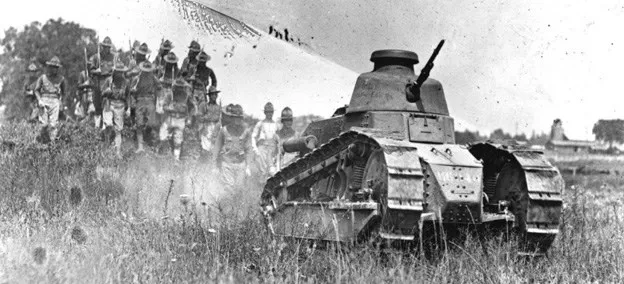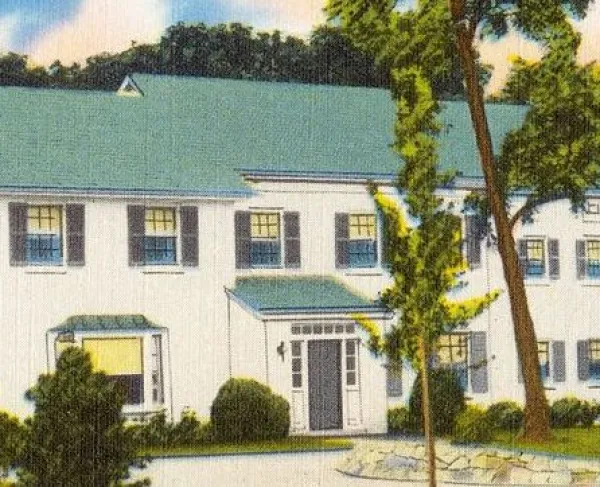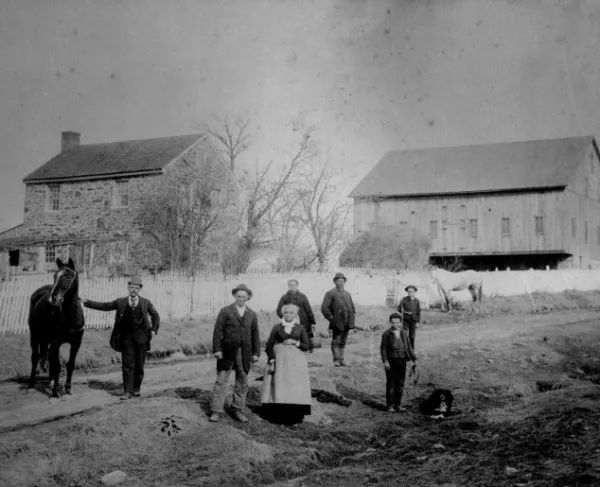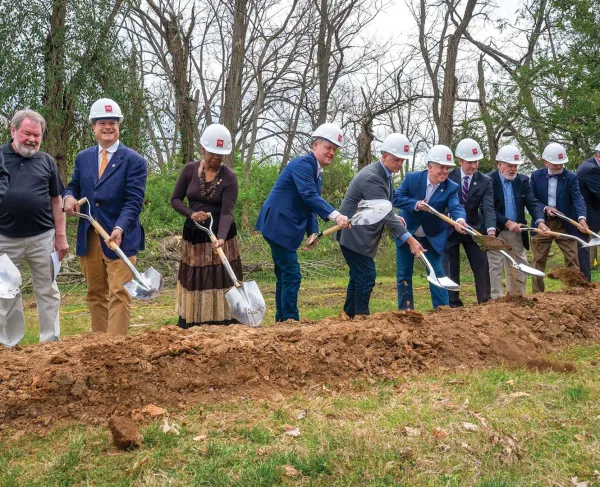Spanish Influenza and Eisenhower's Leadership in Gettysburg

In Gettysburg, rich stories of the town's past are often overshadowed by the leviathan of the battle that unfolded in the summer of 1863. Nevertheless, Gettysburg holds a great deal of additional history that extends beyond the Civil War. Future five-star general and President Dwight D. Eisenhower is a key figure in one of these layers of history as the Army Tank Corps commander at Camp Colt atop the fields of Pickett’s Charge. While commanding the camp, Eisenhower developed his leadership abilities, honing skills that would assist him for the rest of his life as the Supreme Commander of the Allied Expeditionary Force during World War II, as well as President of the United States. In the First World War, Eisenhower's most critical moments as a young officer were during the outbreak of the Spanish Influenza in the Fall of 1918, an unfortunately topical historic event as we witness a new pandemic.
By late September of 1918, the epidemic had come to Camp Colt. Soldiers from Camp Devens, Massachusetts, were reassigned to Gettysburg and many soldiers brought the Spanish Influenza with them. They were not deemed ill when they left Massachusetts, however, and they were not placed in quarantine upon arrival. By the time the illness became apparent throughout camp, the men from Camp Devens had already been divided amongst the rest of the camp and had already infected the camp and town. The Sanitary Report for the Month of September 1918 indicates that Eisenhower had quickly enacted several measures to curtail the spread of illness, including:
- Admit all serious cases to hospital promptly, but not crowd it with light cases to the exclusion later of more serious cases.
- Every man in camp required to have throat and nose sprayed with germicidal solution daily, and checked off on company roster.
- Every man examined when sprayed to prevent hiding symptoms of influenza, and if suspicious signs are present have case followed closely. …
(f) Places of amusement in Gettysburg closed to soldiers and military police prevent soldiers entering stores except in small numbers at one time.
(g) Organizations not allowed to intermingle or form groups in areas of the Camp.
(h) Beds and bedding aired and sunned for entire day. Tents furled for entire day.
These precautions were extremely useful in slowing the spread of the virus. However, many of the measures were extremely unpopular amongst the men, especially the banning of group gatherings. One of the medical personnel later recalled with frustration that the regulations had put an end to craps games. Eisenhower ordered more tents to be put up to allow for isolation of any men with any sort or symptoms, even if the isolation was simply a canvas partition between beds. Additionally, he ordered inoculations against smallpox, typhoid, and other contagious or infectious diseases to be given so that they could not complicate the situation.
Eisenhower also had the forethought to cooperate with the town in order to control the spread of the epidemic. An emergency hospital was created on the upper floor of St. Xavier’s Catholic School, and the local chapter of the American Red Cross provided much needed assistance. There was a lack of Army nurses, and the Red Cross helped to recruit additional assistance as well as providing medical supplies and comfort foods for the ill. Whenever possible, Army medical personnel were sent to assist the townspeople as well. In addition to the use of town buildings and volunteer nurses, Eisenhower helped coordinate the donations of “chicken, meats, eggs, butter, squabs, jellies, fruits, and vegetables,” along with gifts of medical supplies and bedding.

During the epidemic, accusations of Eisenhower's incompetence as camp commander spread, but were found to have no substantial proof. In October, Private Boyd F. Shriver died of pneumonia at Camp Colt. His grieving family, attempting to come to terms with the death of their loved one, wrote a letter to Bishop Arthur Hall in Washington, D.C. asking “Why can’t [the ill soldiers] be attended at the hospital? He wrote to us a week before he died for God’s sake to send some medicine and the doctors would not give him a thing and to send some money that he might get it. He was spitting blood then had pneumonia and they let him die like a dog.” Bishop Hall took this letter to Frederick Wright, the Acting Surgeon General. Taking the complaint seriously, Senator Howard Sutherland of West Virginia began to exert pressure for a full inspection of medical care at Camp Colt. The Medical Corps immediately sent S.J. Morris to represent the Medical Corps and carry out a formal inspection of Camp Colt, especially pertaining to the system of care at the camp for those suffering of pneumonia or the Spanish Flu. He admitted the pneumonia cases were not properly segregated from those with Spanish Influenza and were rather placed aside in a corner or along one side. However, he had very good things to say about the sanitation of both Xavier Hall and the camp hospital, mentioning that the floors were scrubbed daily with antiseptics. In response to accusations that the camp was undersupplied, he wrote that everything was in ample supply, and concluded that “the situation is being handled in a generally satisfactory manner in so far as conditions will permit. The Camp Surgeon and his assistants have very thoroughly carried out the prevailing instructions in regard to such an epidemic.” As far as the United States government was concerned, the report stated that Eisenhower had made the best of a poor situation.
As explained in a letter to Senator Sutherland that cited Morris’ report, any inadequacies of care were due to the fact that Camp Colt was never designed as a permanent military installation. Camp Colt only operated a hospital made of some frame buildings and some tents. However, those conditions met the requirements of a small, short-term camp. Inspectors found it “to be well administered and well adapted to furnish adequate care for the sick,” but admitted that “It was, of course, overtaxed by the influenza epidemic as have been the hospitals in other camps and in civil communities.” Private Boyd’s letter had been sent either in late September or early October, which was the height of the epidemic. As quickly as possible, Eisenhower had expanded the camp hospital into a solid building in town, solving many issues. The Medical Corps concluded that the camp’s medical care was operating in a satisfactory manner, and the conclusion was merely that pneumonia patients should be moved to separate rooms, and that the camp needed more nurses designated to it.
By the end of October, the epidemic had finally abated. The majority of men were able to return to duty, and Xavier Hall was no longer needed as a hospital. The quarantine was lifted, and few new cases developed. The deaths at the Camp had reached 148 by October 26, and eventually grew to 175, but that number was below the average for Army camps. Eisenhower’s quick reaction, early declaration of quarantine, and cooperation with the town of Gettysburg helped keep a terrible situation under control. In fact, once the outbreak was deemed under control, the War Department requested that Eisenhower send thirty of the doctors to explain the measures they took so that they could be replicated elsewhere.

Eisenhower never went overseas during the First World War, and shortly after the epidemic abated, the armistice ended combat on November 11, 1918. Despite his disappointment about staying stateside, Eisenhower’s men fondly remembered his excellent command and management of the Spanish Influenza epidemic. Veteran Walter Hard later wrote that Eisenhower had “integrity and genius tempered with compassions,” and that he “liked Ike 34 years before those I Like Ike buttons appeared.” Another soldier, Chester Beymer, wrote that “Camp Colt, except for the Spanish Flu, was a happy camp. It appeared to us GI’s as a very efficient and well organized operation. Very little of the ‘hurry up and wait.’ Discipline was good and there were hardly any gripes to be heard.”
There, on the same fields that witnessed bloodshed in 1863, a future President and eventual Gettysburg resident led his command through the outbreak of a deadly illness. Many of Eisenhower’s actions in 1918 likely sound familiar to a modern audience. Quarantining those who come in contact with an illness, closing “places of amusement,” creating an area solely for the treatment of those sick with the illness, and banning group gatherings happened both then and now. History isn’t so simple as to only repeat itself, but patterns and similarities may nevertheless teach us lessons. Perhaps we can look back at Eisenhower’s example and see that through perseverance a pandemic can be overcome.
Further Reading:
- At Ease: Stories I Tell to Friends by Dwight D. Eisenhower
- Adams County in the World War: April 6, 1917 to November 11, 1918 By: Paul Foulk and Percy Eichelberger
- "The Army's First Tank School: Camp Colt at Gettysburg" By: the National Park Service
We're on the verge of a moment that will define the future of battlefield preservation. With your help, we can save over 1,000 acres of critical Civil...
Related Battles
23,049
28,063






